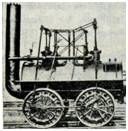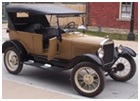|
 |
|
 |
The Industrial Revolution - Management and Unions
The Industrial Revolution (18th – 19th century)
Famous for... The transfer of production in Britain from agriculture to manufacturing that started in the mid-18th century. The textile industry was:
Why did it start in Britain?
1. Steam power In 1775 the Scotsman, James Watt (pictured right), revolutionized steam engines by adding a condenser that:
Watt’s engine powered:
2. Transport
a) roads greatly improved The journey from London to Edinburgh was reduced from two weeks to 2½ days in the second half of the 18th century. b) canals and railways Their construction hugely improved transport. In 1825 George Stephenson designed the first train (the Locomotion No. 1 , pictured right) that:
3. Growing markets From 1750 to 1800 British demand for consumer goods increased by 42% , largely due to the fast
growing middle class of professionals and businessmen. Overseas trade also boomed, helped by:
4. Social mobility There were fewer class barriers in Britain than anywhere else in Europe, helping poor people to become rich and successful (like the textile boss, Richard Arkwright, who was originally a barber). There was a big interest in self-improvement. Samuel Smiles’, pictured right, 1859 book, Self-Help, even outsold
Charles Dickens!.
5. Excellent engineering Railways (and so bridges and tunnels) were built by great engineers like:
6. Philosophy The Scottish philosopher, Adam Smith (pictured right), wrote The Wealth of Nations in 1776 that supported profit making in businesses through:
7. Food British agriculture:
8. Invention The number of patents (protecting new inventions) rose significantly from the mid-18th century onwards - see below.
Key British & American inventions in the Industrial Revolution
1765 James Hargreaves’ (pictured right) spinning jenny (which automated cloth weaving) But some people claim that Thomas Highs invented it.
1775 James Watt’s steam engine. 1821 Michael Faraday’s (pictured right in 1842) electric motor.
1834 Charles Babbage’s (pictured right) first computer.
Two American inventions were also vital:
1793 Eli Whitney’s cotton gin (that automated cotton cleaning). 1837 Samuel Morse’s (pictured right) telegraph.
Why did British industry decline?
From the early 19th century onwards, Britain was overtaken industrially, particularly by America and Germany. The 3 E’s explain why:
1. Education Britain didn’t educate enough people. The best schools (particularly private schools like Eton and Harrow) were anti-business.
2. Empire Britain’s empire provided easy money and markets which made its industry lazy and inefficient. 3. Elitism The powerful British land owning upper classes snobbishly despised the new rich businessmen (as shown in films like Chariots of Fire , pictured right). Class barriers:
This worker unrest was shown in films like How Green Was My Valley and Billy Elliot – see below.
Workers’ woes The Industrial Revolution created:
The poor had to live in:
Workers’ pay and working conditions were atrocious Children worked from the age of five.
Help for the workers
1. Trade (or labour) unions Unions were created to protect the interests of its worker members from the mid-19th century onwards, leading to lots of strikes, particularly in the coal mines.
2. Luddites This was the name given to workers who destroyed machinery that was destroying their jobs. The Luddite movement started in 1811.
3. Chartism This movement (started in 1838) wanted every man to have the vote. At that time poor people had no vote and so no influence over government policy.
4. Kind employers Some employers treated their workers well like:
5. Co-operative societies In 1844 the Rochdale Pioneers in Northern England set up the first co-operative stores that provided workers with:
These stores spread rapidly worldwide.
6. Pro-worker laws The Factory Acts (starting in 1802) improved workers’ hours and working conditions. Food prices were cut significantly by the repeal of the Corn Laws in 1846 that had put a tax on cheap, imported cereal crops like wheat.
What about mass production? In 1798 the American Eli Whitney (pictured right) showed how guns could be mass produced using interchangeable parts. This principle was developed by Henry Ford’s mass
production of the Model T (pictured right) car in 1908, leading
to:
Key quotes on creativity and quality
Everything comes from experiment. - Josiah Wedgwood (Engish pottery manufacturer, pictured right).
A composition for cheapness and not excellence of workmanship is the most frequent and certain cause of the rapid decay and entire destruction of arts and manufactures. - Josiah Wedgwood (English pottery manufacturer).
Key quotes on workers and unions Happiness is achieved by the union and co-operation of all for the benefit of each. - Robert Owen (English mill owner).
Machinery creates wealth but destroys men. - George Cadbury (English chocolate maker).
Workers of the world unite! - Karl Marx , pictured right and Friedrich Engels in The Communist Manifesto.
|
|
|
||
|
|
|
||
|
||
| Copyright © wisdomtowin.com All Rights Reserved | ||
|

 right in 1790,
right in 1790,


















